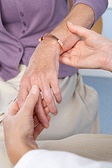| English: Lifting backpack (Photo credit: Wikipedia) |
The most common overuse syndrome characterized by inflammation or degeneration at the common extensor tendon that joins the forearm muscles to the lateral epicondyle of the elbow. The forearm muscles and tendons become damaged from overuse leading to pain and tenderness on the outside of the elbow. It is a strain injury from playing tennis or other racquet sports. However, you can still get tennis elbow even if you are not a tennis player and is actually more common in non-tennis players. Any repetitive gripping activities or several other sports can also put you at risk. The structures primarily involved are the wrist extensors, particularly the extensor carpi radialis brevis. It also affect the extensor digitorum, extensor carpi radialis longus, and extensor carpi ulnaris.
II. Functional Anatomy
A synovial hinge joint formed between the distal end of the humerus in the upper arm and the proximal ends of the ulna and radius in the forearm. The elbow joint complex made up of four articulation, the humeroulnar, humeroradial, superior radioulnar, and inferior radioulnar joints. Muscles, ligaments, and tendons hold the elbow joint together to provide functional movements and dynamic stabilization to perform skilled and precise motions. The coordination of multiple muscles allows two degrees of freedom of movements, the combinations of flexion-extension and pronation-supination. The two epicondyles are actually the bony protuberance at the distal end of the humerus, the medial and lateral epicondyle. The forearm muscle tendons attach the muscle to bone. In lateral epicondylitis, the injury is on the tendon attachment on the lateral epicondyle of the humerus. The tendon usually involved is the Extensor Carpi Radialis Brevis (ECRB). Experiences pain and localized tenderness in the lateral side of the elbow.
| Elbow - coude (Photo credit: Wikipedia) |
III. Contributing factors
1. Overuse
Any repetitive wrist action against resistance during extension and supination may produce damage to the forearm muscle, particularly the extensor carpi radialis brevis muscle which stabilizes the wrist when the elbow is in extension. An example is ground stroke (backhand) in tennis.
2. Work and Activities
There is a risk to any work or leisure activities that has no proper training, techniques, and equipment.
- Tennis/Racquetball/Squash - Check equipment for proper fit
- Fencing
- Weight Lifting
- Painters/Painting
- Carpenters/Bricklayers/Plumbers
- Seamstresses/Tailors
- Cooks /Butchers
- Politicians (excessive handshaking)
- Musicians (pianists, drummers)
- Raking
- Knitting
- A lot of typing
- A lot of mouse work
It is more common to individuals in their late 30's and 50's secondary to the normal loss of extensibility of connective tissue with age
4. Symptoms
The symptoms of tennis elbow include pain and localized tenderness along the lateral aspect of the elbow especially over the lateral epicondyle that sometimes radiates into the dorsum of the hand although the damage is in the elbow. Pain usually increases with activity like picking up an object, holding a glass/cup, opening a door, or making shake hands. The elbow ROM is usually normal and involved only one side.
IV. Diagnosis
1. History Taking
- Information from patient
- Age of the patient (usual age group affected 30 to 50 years of age)
- How your current symptoms developed and medications
- Any occupational risk factors
- Recreational sports activities
- Family and Past medical history like an elbow injury before, history of rheumatoid arthritis or nerve disease
- Inspections for swelling or ecchymosis.
- Palpation of the extremity for pain and tenderness at the lateral epicondyle
- The severity, the occurrence, and location of pain in relation to movement/activity
- Always examine ROM of the shoulder, elbow, and wrist on the affected side to evaluate for radiohumeral bursitis, osteochondritis of the capitellum, or PIN entrapment.
3. Tests
- Laboratory and imaging studies rarely needed
- X-ray or MRI (magnetic resonance imaging) to diagnose tennis elbow or rule out other problems like osteophytes, degenerative joint disease, or stress fracture
- Electromyography if there is radial nerve involvement
- Special orthopedic tests
- The examiner palpates the patient’s lateral epicondyle with a thumb while passively pronating the forearm, flexing the wrist and extending the elbow.
- Positive test is reproduction of pain near the lateral epicondyle
- This test is also to use to indicate radial nerve involvement
- Patient actively make a fist, pronate the forearm as well as radially deviate and extend the wrist against a counterforce that is being applied by the examiner.
- The positive test is the reproduction of pain near the lateral epicondyle.
- The examiner resists the extension of the 3rd digit of the hand while stabilizing more proximal
- The positive test is the reproduction pain or discomfort in the region of the lateral epicondyle because it stress the extensor muscles and tendon
V. Differential Diagnoses
- Medial Epicondylitis
- Cervical Radiculopathy
- Plica Syndrome
- Elbow and Forearm Overuse Injuries
- Little League Elbow Syndrome
- Radial Nerve Entrapment
Medical Intervention:
There are many treatment options for tennis elbow geared toward the goals of decreasing inflammation and analgesia.
Nonsurgical Treatment
1. The patient is advice to avoid activities or work that aggravates the injury and treats pain and inflammation with protection, rest, ice, compression, and elevation.
2. Pharmacological intervention
- Non-steroidal anti-inflammatory drugs (NSAIDs) for pain and inflammation such as ibuprofen, naproxen, or aspirin
- Monitor the effects on the gastrointestinal (GI) tract and renal function with long-term use
- Topical NSAID such as diclofenac may offer some short-term relief.
- Ultrasound phonophoresis with hydrocortisone
- Electrical stimulation iontophoresis with NSAIDs and/or corticosteroid (dexamethasone)
5. Physical therapy
- Stretching to improve flexibility
- Strengthening to increase functional activities
- Progress from concentric to eccentric exercises and then resisted exercises as tolerated
- All exercise should be pain-free
- Stretch and warm up before any sport or activity that will exercise your elbow or arm.
- Apply ice on your elbow after exercise
Surgical Treatment
1. Recommended if the symptoms do not respond after 6 to 12 months of nonsurgical treatments
2. Surgical Option:
a. Open surgery
- The most common approach to tennis elbow repair that involves making an incision over the elbow.
- This outpatient procedure involves using miniature instruments and small incisions.
- Usually last 4 to 6 months postop
- Start the exercise with stretching and light, gradual strengthening exercise 2 months postop
- Infection
- Nerve and blood vessel involvement
- Long-term rehabilitation process
- Loss of strength
- Loss of flexibility
- Possibility of another surgery
- Give the same therapeutic program to the patient
- Patient education on modification of the activities that exacerbate the symptoms and use ice, elevation and rest as needed
- Advice patient about continued stretching and excercise to decrease the risk of recurrence
- Advice about the danger of rushing the recovery as it may worsen the damage
Related articles










































